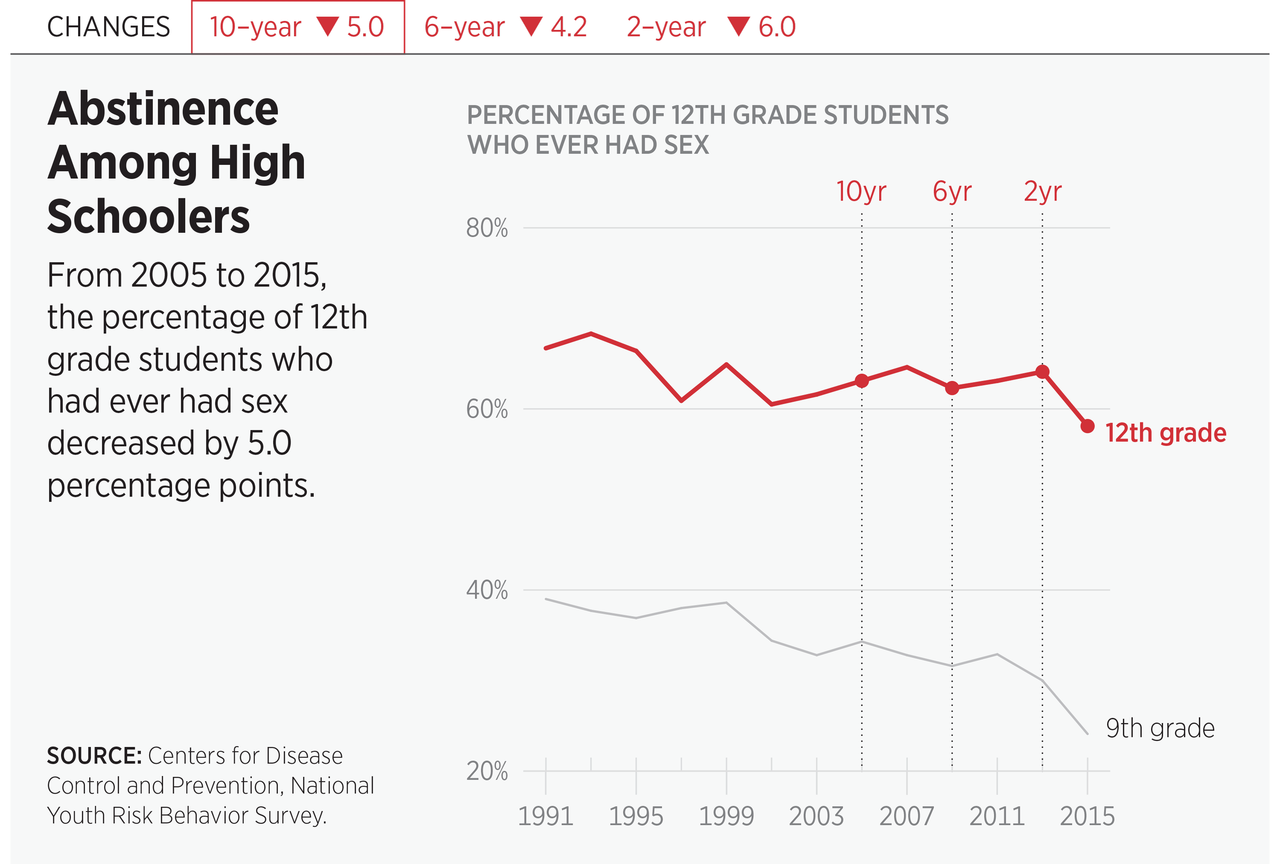The 10-year decline in the percentage of high school students who have had sex should be a cause for modest hope. This year’s rate is lower than at any other point in the history of this indicator going back to 1991. Studies indicate that the younger a person is at the time of his or her first sexual encounter, the higher the likelihood is that he or she will have a greater number of sexual partners over time.1 A greater number of sexual partners is negatively correlated with future marital stability,2 emotional health,3 and other life outcomes. That fewer teens are having sex is therefore an encouraging trend but one that should be considered within the context of a culture in which the ideology of the sexual revolution still prevails.
Perhaps nowhere else is the legacy of the sexual revolution felt more pervasively than on our university campuses, where uncommitted sexual encounters (“hookups”) are commonplace. Various studies suggest that somewhere between 60 percent and 80 percent of North American college students have engaged in a hookup.4 Yet several of these students report negative emotional experiences afterward, with around one-fourth reporting feelings of loss of respect and one-fifth reporting emotional difficulties.5
The past two decades have brought additional challenges for building a culture of sexual integrity. Recent technological advancements have made possible instant access to vast amounts of pornographic material as well as the rapid sharing of private, sexually explicit content. While few statistics regarding adolescent exposure to pornography are available, a survey conducted in 2005 estimated that approximately 42 percent of teens ages 10 to 17 had been exposed to Internet porn that year. Two-thirds of these teens reported their exposure as unwanted6—the result, perhaps, of the aggressive marketing practices of the porn industry.
“Sexting” has also become an increasingly common practice among teens. One study estimates that approximately 10 percent of youth ages 10 to 17 have appeared in, created, or sent sexually suggestive photos or videos.7 In sexting, images are less prevalent than sexually suggestive messages, which, according to one online survey, nearly 39 percent and 48 percent of teens ages 13–19 had admitted to sending and receiving, respectively.8 Many who receive pornographic photos through sexting share them nonconsensually with others, contributing to the “revenge porn” phenomenon, an insidious clash of the sexting and porn worlds.
What, then, can we do to rebuild a culture of sexual integrity?
First, we must continue to foster rational, civil engagement regarding sexual ethics within the academy, among educational and medical experts, between policymakers, and—especially—within families. Recent controversies might lead us to believe that ours is a culture so heavily oppressed by political correctness, that it is neither possible nor worthwhile to promote sexual integrity in the public square. However, we owe it to the next generation to present thoughtful public arguments in favor of a sexual ethic that frees them to be better future lovers, spouses, and parents.
Second, we must work to engage the “storytelling” industries: film, marketing, and journalism, all of which have a profound influence on social and political opinion. Efforts to promote sexual integrity have long been the purview of traditional religious, academic, or educational professionals, with limited engagement of artistic storytellers. The effectiveness of religious ministries or educational work will only be enhanced if more people are exposed to stories with clear-eyed portrayals of the difficulties and rewards of self-sacrificing love.
Whether the sexual revolution will maintain its grip on the next generation depends on our willingness to witness to the truth that a flourishing civil society is one built on strong marriages and happy families and that those in turn are built on personal virtue and an unwavering commitment to sexual integrity.
Judy Romea is Associate Director of the Zephyr Institute in Palo Alto, California.
ENDNOTES:
1. Jennifer Nield, Briana M. Magnusson, Derek A. Chapman, and Kate L. Lapane, “Age at Sexual Debut and Subsequent Sexual Partnering in Adulthood Among American Men,” American Journal of Men’s Health, Vol. 8, No. 4 (December 10, 2013), pp. 327–334, http://journals.sagepub.com/doi/pdf/10.1177/1557988313514768 (accessed April 5, 2017); Brianna M. Magnusson, Jennifer A. Nield, and Kate L. Lapane, “Age at First Intercourse and Subsequent Sexual Partnering Among Adult Women in the United States, a Cross-Sectional Study,” BMC Public Health, Vol. 15, No. 98 (2015), https://www.ncbi.nlm.nih.gov/pmc/articles/PMC4328838/pdf/12889_2015_Article_1458.pdf (accessed April 29, 2017).
2. Nicholas H. Wolfinger, “Counterintuitive Trends in the Link Between Premarital Sex and Marital Stability.” Institute for Family Studies, June 6, 2016, https://ifstudies.org/blog/counterintuitive-trends-in-the-link-between-premarital-sex-and-marital-stability (accessed April 29, 2017).
3. Sandhya Ramrakha, Charlotte Paul, Melanie L. Bell, Nigel Dickson, Terrie E. Moffitt, and Avshalom Caspi, “The Relationship Between Multiple Sex Partners and Anxiety, Depression, and Substance Dependence Disorders: A Cohort Study.” Archives of Sexual Behavior, Vol. 42, No. 5 (July 2013), pp. 863–872, https://www.ncbi.nlm.nih.gov/pmc/articles/PMC3752789/pdf/nihms499028.pdf (accessed April 29, 2017).
4. Justin R. Garcia, Chris Reiber, Sean G. Massey, and Ann M. Merriwether. “Sexual Hookup Culture: A Review,” Review of General Psychology, Vol. 16, No. 2 (2012), pp. 161–176, http://www.apa.org/monitor/2013/02/sexual-hookup-culture.pdf (accessed April 29, 2017).
5. Melissa A. Lewis, Hollie Granato, Jessica A. Blayney, Ty W. Lostutter, and Jason R. Kilmer, “Predictors of Hooking Up Sexual Behaviors and Emotional Reactions Among U.S. College Students.” Archives of Sexual Behavior, Vol. 41, No. 5 (October 2012), pp. 1219–1229, https://www.ncbi.nlm.nih.gov/pmc/articles/PMC4397976/pdf/nihms-677450.pdf (accessed April 29, 2017).
6. Janis Wolak, Kimberly Mitchell, and David Finkelhor, “Unwanted and Wanted Exposure to Online Pornography in a National Sample of Youth Internet Users,” Pediatrics, Vol. 119, No. 2 (February 2007), pp. 247–257, http://www.unh.edu/ccrc/pdf/CV153.pdf (accessed April 29, 2017).
7. Kimberly J. Mitchell, David Finkelhor, Lisa M. Jones, and Janis Wolak, “Prevalence and Characteristics of Youth Sexting: A National Study,” Pediatrics, Vol. 129, No. 1 (January 2012), http://pediatrics.aappublications.org/content/129/1/13 (accessed April 29, 2017).
8. National Campaign to Prevent Teen and Unplanned Pregnancy, “Sex and Tech: Results from a Survey of Teen and Young Adults,” December 2008, p. 1, https://thenationalcampaign.org/sites/default/files/resource-primary-download/sex_and_tech_summary.pdf (accessed April 29, 2017).


